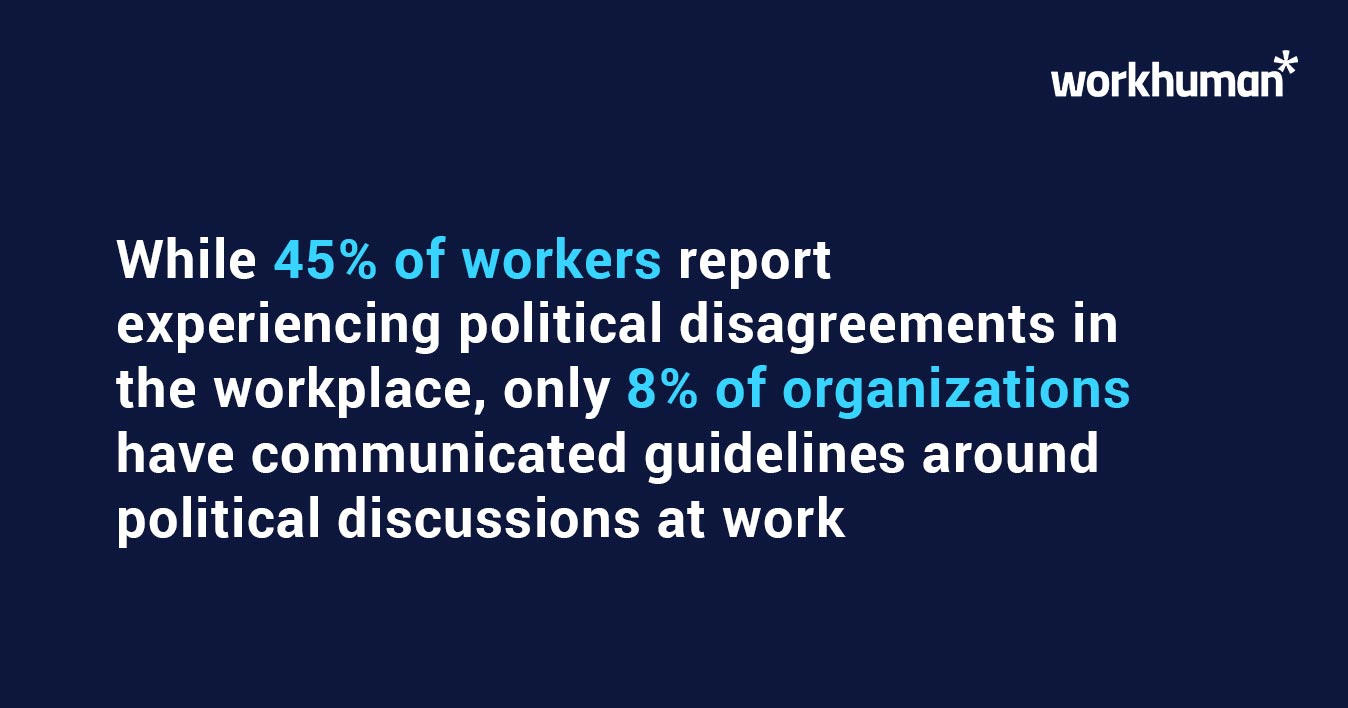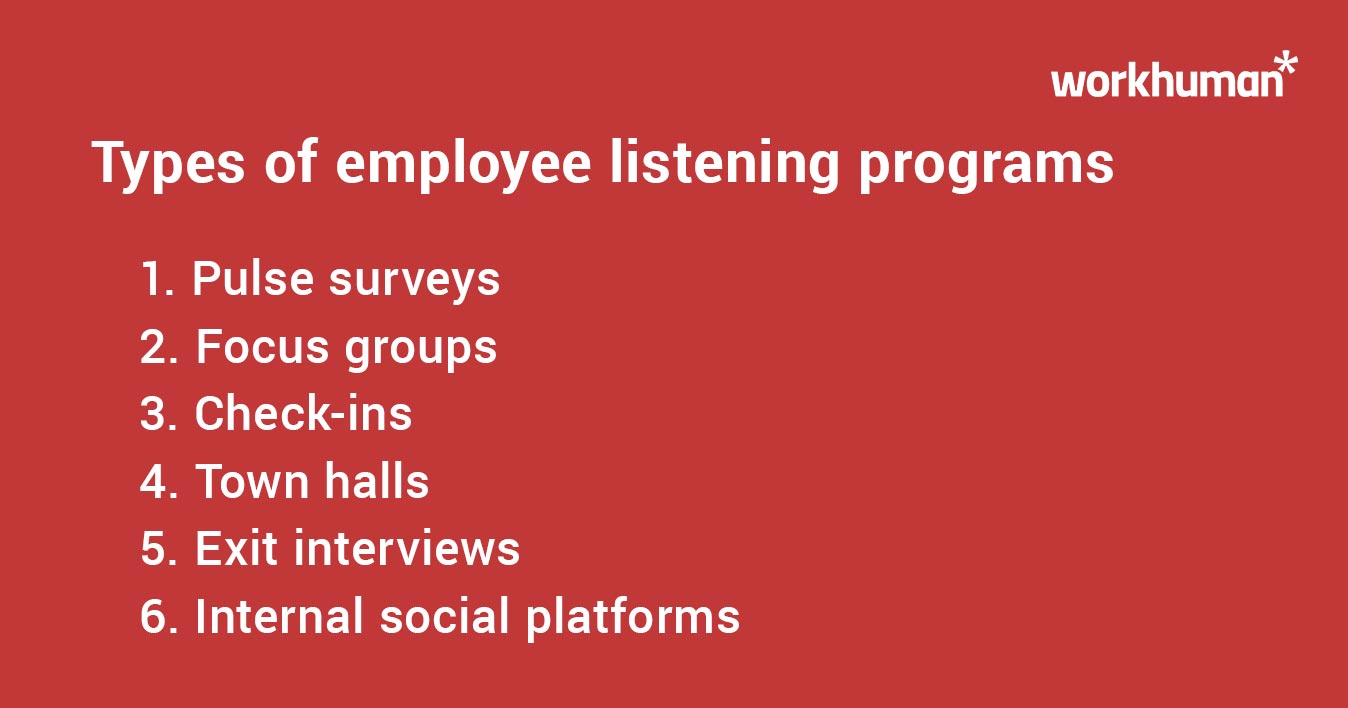Hone Your Employee Listening Strategy - Plus Examples You Can Use

Stressful headlines from around the world flash across your employees’ laptops and phones during all hours of the day. Attempting to process the weight of these traumatic events can cause even the most dedicated individuals to mentally disengage from work and feel unable to recharge during off hours.
The stress of these events can create a workforce that is burnt out and eager for employer support. How can organizations provide a safe space for employees to vocalize their valid worries and learn how employers can help?
When done right, these empowering programs can serve as a much-needed anchor for employees and act as a valuable source of information for employers to address concerns.
Keep reading to learn how your organization can effectively implement an employee listening strategy.
The effects of stressful events on employees
Political rulings, elections, wars, targeted demographic violence, climate crises, natural disasters, and social unrest are just a handful of the events causing unprecedented strain on workers.
In combination with the uptick in mental health challenges, stressful events cause anxiety, fear, and feelings of hopelessness. These worries distract employees from work as they attempt to process how these events affect their communities and the world around them.
Heightened stress does not turn “off” when an employee clocks out. These fears spill into a worker’s time causing a vicious cycle where an individual can't relax on their time off and returns to work feeling unrefreshed. This is a surefire path to burnout.
When your workforce is struggling, your business bears the consequences. Your organization will experience decreased productivity and engagement, hindered innovation, stressful and uneven team dynamics, and employee turnover. Additionally, employees may begin to lose trust and commitment in the organization when there is a lack of acknowledgment or response regarding traumatic events.
The role of employee listening programs
Employee listening programs offer ways for organizations to listen and gather feedback from employees. These programs help organizations understand specific employee sentiments and needs, and then analyze and respond to valuable information to address concerns and provide resources.
On top of that, these programs can provide much-needed guidelines on how employees can constructively discuss charged feelings regarding world events. A press release by SHRM, "Study Reveals 20% of Workers Mistreated Due to Political ViewsOpens in a new tab", found that while 45% of workers report experiencing political disagreements in the workplace, only 8% of organizations have communicated guidelines.

Employee listening programs help foster an open culture of transparency, empathy, and communication. For employees, this leads to improved well-being, stronger workplace relationships, and increased trust in their organization’s leadership and brand. These programs offer employers the valuable opportunity to practice responsiveness and adaptability.
See also: How to Use the 5 Languages of Appreciation at Work and Make Employees Feel Valued
While the use of employee listening programs is critical during crises, these programs should not only be reserved for taxing moments but instead be adopted as a continuous practice. Regular employee listening builds resilience and trust over time, strengthening your organization.
Types of employee listening programs
There is a range of qualitative and quantitative types of employee listening programs available to adopt. We suggest exploring and testing out a combination of methods and channels to understand what serves your employees best.
Pulse surveys
Unlike annual, lengthy employee engagement surveys, employee pulse surveys are frequent and short surveys that help to capture real-time employee feedback and gauge the health of an organization’s culture. As an added benefit, additional off-cycle surveys can be easily deployed whenever the organization deems it necessary.
Craft actionable, but not leading, questions that capture employee wellbeing, stress levels, and coping mechanisms. For example, instead of asking "Are you happy at work?" ask "Do you feel like you have the resources you need to succeed in your role?"
Ensure employees know that there is true anonymity – giving feedback and worrying there's a chance you could be penalized for it will only increase an employee's anxiety. Without guaranteed privacy, employees may not feel a strong enough sense of psychological safety to share honest responses.
Focus groups
Focus groups help organizations dig deeper into the results of a pulse survey and uncover the “why” and nuances of employee responses. Optional, in-depth discussions with small groups of employees can inspire creative, employee-driven improvements.
It can be healing for employees to know that they are not the only ones struggling or feeling intense emotions. These sessions offer workers the opportunities to collaboratively build off their ideas and share why they feel a certain way.
Employers can work together with employee resource groups (ERGs) to connect employees with others who are experiencing similar challenges or reactions to a difficult world event. ERGs provide a safe space for underrepresented voices to share their insights and feel heard.
Check-ins
Private, one-on-one conversations between a manager and a direct report, or just two colleagues, increase feelings of support and enhance morale. Check-ins provide managers the opportunity to identify who may be struggling so that they can provide resources or accommodations that can offer relief.
Identifying employees who are struggling requires leaders to utilize their listening strategies and rely on their listening comprehension skills. Managers can listen to the person talking and observe their body language and facial expressions to determine who may need special attention.
Following these listening strategies helps an employee feel heard. When an employee knows someone is looking out for their best interests and cares about their wellbeing, they feel a deepened sense of security and renewed commitment to their work.
Learn more about the importance of transparency and frequent check-ins in this white paper, "Performance in the Future of Work.
Town halls
Large-scale virtual and/or in-person gatherings create a safe space for collective sharing and open dialogue. Town halls help combat misinformation by providing a space for organizations to clearly, and consistently, communicate information about the event and their response.
Town halls offer a sense of community and opportunity for open dialogue. Ask-me-anything (AMA) sessions allow employees to pose questions to leadership and hear their responses in real-time.
The candid nature of these company-wide conversations can help to build trust in the organization’s commitment to providing support.
Exit interviews
An employee might feel inclined to be forthcoming and vulnerable about cultural issues that they face or witness when they are on their way out of the organization. Actively listening to departing employee suggestions can help extract valuable insights and gaps that can frame your employee listening program strategy and workplace culture moving forward.
Internal social platforms
Part of processing stressful feelings comes from talking to others about them. Internal social platforms, like Slack or Microsoft Teams, offer a cathartic place for discussion or support throughout the small moments of the day. Providing employees with a place to share their feelings in their own time, without a scheduled or formal meeting, promotes feelings of safety.
Additionally, employers can utilize these online forums to address breaking news before issuing a formal internal or external company statement. Employees will feel heard and appreciate the acknowledgment, leading to increased feelings of safety and trust in the workplace.

Responding to employee voices effectively
Analyzing and interpreting employee voices is just the beginning of the feedback process. It is critical to act on what your organization learns, demonstrating that employee voices matter and that your company is committed to doing things right and providing an improved workplace experience.
Taking an actionable response based on common concerns might look like this:
- Flexible work accommodations,
- Ongoing communication and support sessions that help employees access their mental health and wellness benefits with ease,
- Sustainable upgrades like reducing company “swag” and offsetting or minimizing emissions due to travel and/or commutes,
- Information sessions on world events,
- Company-wide volunteer and/or fundraising opportunities to support communities affected by events.
Conclusion
Employee listening programs can lead to improved employee wellbeing, increased employee retention, and a more sustainable, engaged business. Prioritize empathy, active listening, and continuous improvement in your continuous listening strategy, and don’t wait until the next headline breaks – start building a culture of listening today.
About the author
Alicyn Zall
Alicyn Zall is a writer dedicated to creating a more equitable and fulfilling workplace. With a focus on actionable, data-driven insights, her work empowers individuals and organizations to foster positive change. In addition to her contribution at Workhuman, Alicyn has served as an editor at Harvard Business Review where she developed books and articles about mental health and the future of work.